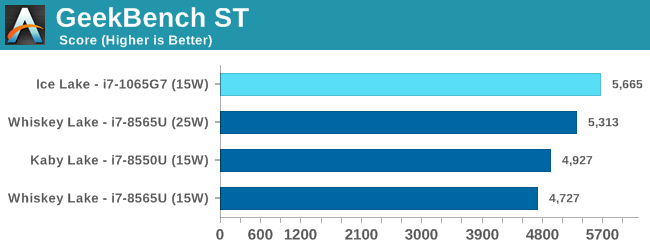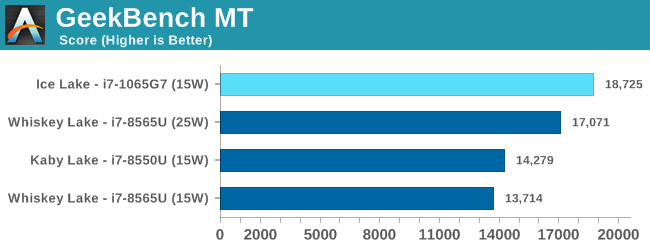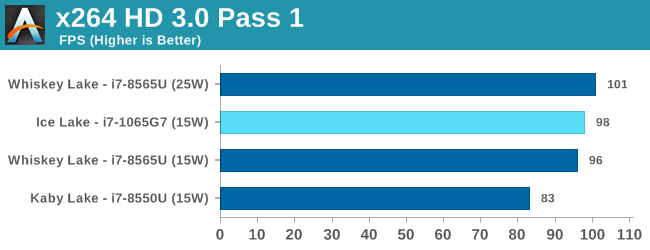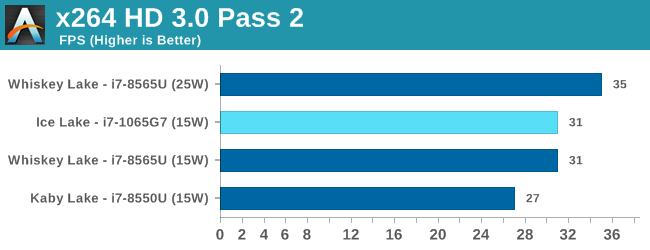The Ice Lake Benchmark Preview: Inside Intel's 10nm
by Dr. Ian Cutress on August 1, 2019 9:00 AM EST- Posted in
- CPUs
- Intel
- GPUs
- 10nm
- Core
- Ice Lake
- Cannon Lake
- Sunny Cove
- 10th Gen Core
Synthetic and Legacy Results (15W)
The realm of synthetic testing is a tricky one, given that there are plenty of benchmarks in the wild that provide a number, but aren’t actually based on real workloads, or are very limited in what they actually test. The issue here is that this software tries to emulate real-world, but it isn’t immersed in the harnesses or matrix of what a user might actually experience. For that reason, we only tend to use these benchmarks based on reader requests.
Legacy benchmarks are included for similar reasons, but can help to get a historical perspective.














261 Comments
View All Comments
unclevagz - Thursday, August 1, 2019 - link
I am assuming that Ice lake-Us aren't all i7s, because that's what the first page table is listing.Also, when you have more time, would it be possible to put spec2k6/2k17 test results of other processors at 3.9ghz for a more direct IPC comparison? Not to mention it'd be nice to list results from mobile SoCs (A12, SD855 etc) just for reference as well.
Ryan Smith - Thursday, August 1, 2019 - link
Thanks!DanNeely - Thursday, August 1, 2019 - link
The first table of CPUs lists all the models as i7, not i7/5/3 as described in the article text.ToTTenTranz - Thursday, August 1, 2019 - link
Is it my impression or the 15-25W TDP switch is only affecting the CPU power budget while leaving the GPU intact?It's making no difference in gaming workloads except for the WoW benchmark, where at >200 FPS we're clearly looking at a CPU-limited scenario.
What's VRS? The Variable Rate Shading test from 3dmark? Could that somehow be CPU-limited too?
Ian Cutress - Thursday, August 1, 2019 - link
Correct on the CPU budget.For variable rate shading, see here: https://www.anandtech.com/show/14514/examining-int...
I'll update the article too
ToTTenTranz - Thursday, August 1, 2019 - link
Thanks for the response Ian.Did you ask them if this is something Intel will tweaking this further?
It seems that the 25W mode is leaving a lot of GPU performance on the table, and in GPU-intensive tasks they'd gain a lot more by keeping the CPU power budget intact while providing more headroom for higher clocks on the GPU.
This would be akin to what AMD is doing with mobile Raven Ridge and Picasso, but Intel has a major bandwidth advantage here.
Ian Cutress - Thursday, August 1, 2019 - link
I'm not sure how well the GPU clocks if you push the power. We haven't seen many Intel mobile IGPs go above 1100/1150 in quite a while. I wonder if there's a limit there, or simply Intel needed a minimum CPU performance and whatever was left went to the GPU.Lots of ways to slice it. Only Intel knows for sure.
eastcoast_pete - Thursday, August 1, 2019 - link
Plus, the iGPU will likely run into the speed limitations of having to use system RAM. Not sure how far one has to push the 64 EUs before they start to do the silicon equivalent of twiddling their thumbs waiting for the memory. Might be an interesting thing to test once Ice Lake is released into the wild.0ldman79 - Friday, August 2, 2019 - link
I'd like to see a comparison of the iGPU vs the Gen9 iGPU.It's more powerful per EU and there are a little over twice as many EU vs the previous models. That being said, the 530 was decent, I could play games at 720P low settings with decent framerates, but even at 3 times the performance that's still not enough to play those games at 1080p.
SoulShadow - Thursday, August 1, 2019 - link
How does Ice Lake look with an eGPU setup? Is it still going to be mediocre?Been thinking about dumping my Ryzen 7 1700 desktop and tossing the 1080ti into an eGPU enclosure with a laptop.
Would be far more convenient I'm just concerned about bad performance loss from moving to a 25/45w cpu